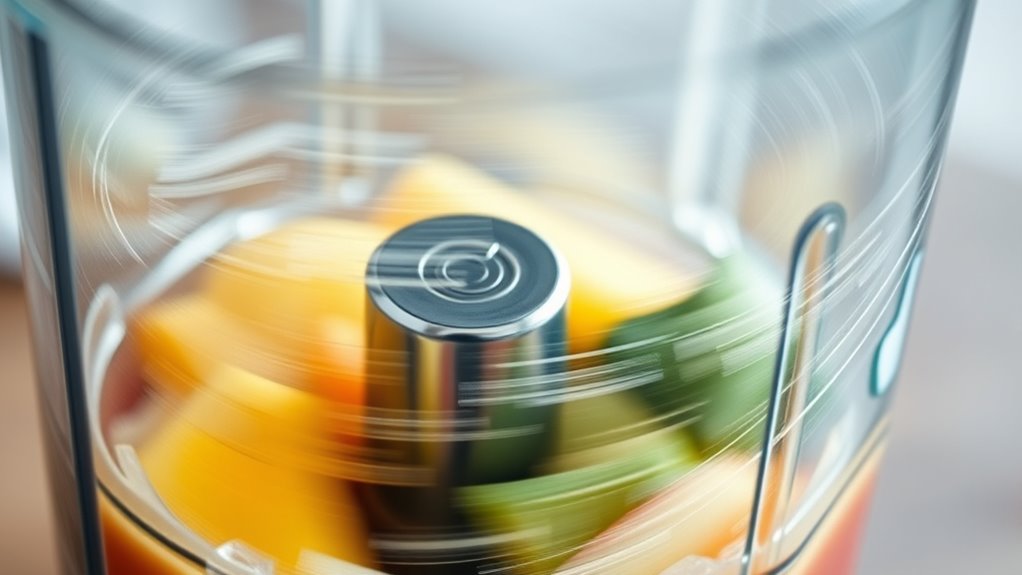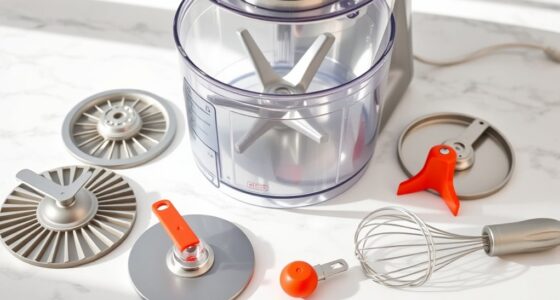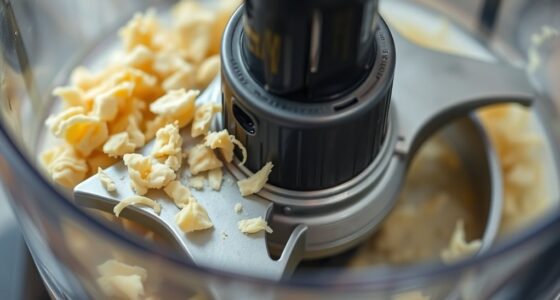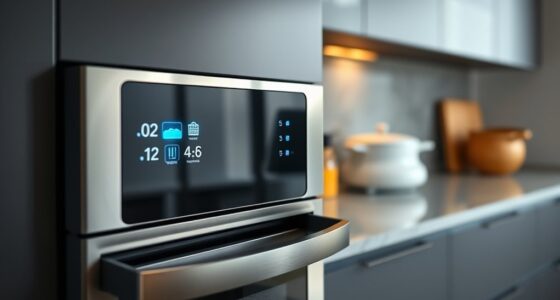Blender blades and the power behind them are carefully engineered to give you smooth, consistent results. High-quality materials like stainless steel resist wear and guarantee durability, while blade geometry—angles and edges—improve cutting and blending efficiency. The motor’s torque and RPM work together to tackle tough ingredients without overheating. Innovations focus on safety, noise reduction, and eco-friendly designs. Want to understand how these elements combine for perfect smoothies? Keep exploring to uncover the engineering secrets.
Key Takeaways
- Blade materials like stainless steel ensure durability, sharpness, and corrosion resistance for consistent blending performance.
- Blade geometry, including angle and edge type, optimizes cutting efficiency and ingredient vortexing.
- Proper maintenance, including sharpening and cleaning, maximizes torque transfer and blending effectiveness.
- High blade speed and torque enable efficient processing of tough ingredients and smooth textures.
- Advanced designs incorporate noise reduction, safety features, and ergonomic blades for improved performance and longevity.
The Anatomy of Blender Blades

Have you ever wondered what makes blender blades so effective at chopping and blending? It all starts with their sharp, sturdy design, crafted for efficient performance. To keep them working at their best, proper blade maintenance is essential. Regularly inspecting your blades for dullness or damage ensures ideal blending. Cleaning techniques are equally important; always rinse immediately after use to prevent residue buildup. For a thorough clean, fill the blender with warm water and a drop of dish soap, then run it briefly. Use a brush or sponge to scrub away stubborn debris, especially around the blade edges. Avoid harsh abrasives that could dull the blades. Well-maintained blades stay sharper longer, delivering smooth results every time. Proper blade care maximizes performance and extends their lifespan. Silky smooth blending results depend on both the blade design and maintenance practices.
Blade Materials and Their Impact on Performance
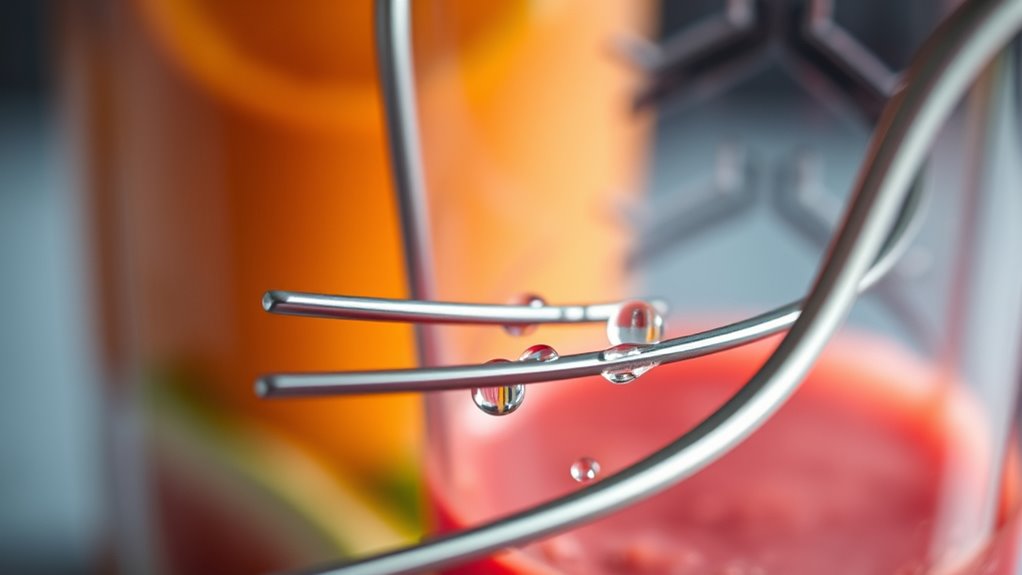
The materials used in blender blades directly affect how well they last and perform. You’ll notice differences in how sharp the edges stay and how easily they cut through various foods. Choosing the right metal can make a big difference in your blending experience. For example, blade materials that are more durable can withstand harsher use and maintain sharpness longer, ensuring consistent blending performance over time.
Durability of Metals
Since the durability of blade materials directly influences a blender’s performance, choosing the right metal is essential. You want blades that resist metal fatigue, which can cause cracking or breaking over time, especially with regular use. High-quality metals like stainless steel offer excellent corrosion resistance, protecting against rust and degradation from moisture or acidic ingredients. This resistance ensures your blades stay sharp longer and maintain their structural integrity. Metal fatigue can lead to weakened blades, reducing blending efficiency and safety. Additionally, advancements in AI safety measures contribute to the development of more resilient and reliable blade materials. By selecting metals that withstand repeated stress and resist corrosion, you ensure your blender remains reliable and effective. Ultimately, durable blade materials mean fewer replacements, consistent performance, and a smoother blending experience every time.
Blade Sharpness and Edge
Ever wondered how the sharpness of your blender blades affects their performance? It all comes down to edge precision. A sharper blade maintains its edge longer and cuts ingredients more efficiently. Here’s how it impacts you:
- Faster blending – sharper blades reduce the effort needed to break down ingredients, saving you time.
- Smoother textures – precise edges create uniform blends, perfect for smoothies and soups.
- Less strain on motor – a sharp edge means the motor doesn’t work as hard, extending its lifespan.
- Better nutrient retention – efficient cutting preserves nutrients, giving you healthier drinks.
- Enhanced durability – blades made from quality blade materials resist dulling, ensuring consistent performance over time.
Blade sharpness directly influences blending quality and durability. Choosing blades with superior edge precision ensures smoother, quicker, and more reliable results every time.
Compatibility With Foods
Have you ever considered how the material of your blender blades influences their ability to handle different foods? The right blade material guarantees food safety by resisting corrosion and preventing contamination. Stainless steel blades are most common, offering durability and resistance to rust, making them suitable for tough ingredients like ice and fibrous vegetables. Some materials, like ceramic blades, excel in food safety because they resist bacteria buildup, but they can be brittle and prone to chipping. Cleaning considerations are also important; stainless steel blades are easy to clean and dishwasher safe, reducing the risk of residue buildup, while other materials may require more delicate handling. Choosing the right blade material impacts performance, safety, and ease of maintenance, ensuring your smoothies stay smooth and safe. Additionally, understanding practical support for seniors can help in maintaining a safe environment when using kitchen appliances.
The Geometry and Design of Blade Edges

The geometry and design of blade edges play a crucial role in determining a blender’s cutting efficiency and performance. A well-crafted blade edge ensures you blend ingredients smoothly and quickly. Here’s what influences it:
- Sharpness: A sharper blade edge cuts through ingredients more easily, reducing strain on the motor.
- Angle: The angle of the blade edge affects how well it slices and pulls ingredients into the vortex.
- Edge Type: Straight, serrated, or curved edges each serve different purposes, impacting blending speed and texture.
- Blade Thickness: Thinner edges cut more precisely, while thicker edges add durability and strength.
- Proper Maintenance: Regular inspection and sharpening of blades help maintain optimal cutting efficiency and extend the lifespan of the blades.
Optimizing these aspects enhances cutting efficiency, giving you smoother smoothies with less effort.
How Motor Torque Affects Blending Power

Your blender’s motor torque directly influences how effectively it can handle tough ingredients. When torque is high, blade speed increases, making blending smoother and faster. Understanding how power transfer efficiency plays into this can help you choose a blender that meets your blending needs. Additionally, selecting a blender with appropriate space and organization features can make maintenance and cleaning more manageable, ensuring optimal performance over time.
Torque and Blade Speed
Ever wondered how motor torque influences a blender’s ability to crush tough ingredients? Higher torque allows blades to spin faster without stalling, boosting blending power. But increased blade speed can lead to more blade noise, which might bother you during use. Here’s how torque and blade speed work together:
- Stronger torque helps blades cut through tough ingredients smoothly.
- Faster blade speeds increase blending efficiency and reduce processing time.
- Blade noise rises with higher speeds, so quieter models are often designed with safety in mind.
- User safety is vital; controlling blade speed prevents accidents and guarantees safe operation.
- Proper maintenance and safety standards ensure the blender operates reliably and safely over time.
Balancing torque and blade speed ensures you get powerful blending without compromising safety or creating excessive noise.
Power Transfer Efficiency
While motor torque provides the raw power needed for blending, how effectively that torque translates into actual blending performance depends on power transfer efficiency. If your blender’s components, like blades, aren’t sharp or properly maintained, much of that torque gets wasted through slipping or inefficient motion. Regular blade sharpening and maintenance guarantee maximum transfer of torque, allowing the motor’s power to be fully utilized. This means smoother, faster blending with less strain on the motor. Poorly maintained blades create resistance, reducing efficiency and potentially overheating the motor. To get the most out of your blender, keep blades sharp and check for wear regularly. Proper maintenance maximizes power transfer efficiency, giving you consistently better blending results with less effort.
The Role of Blade Speed and RPM

Blade speed and RPM directly influence how effectively a blender can process ingredients. Higher speeds break down tougher foods faster and create smoother textures. To optimize performance, consider these factors:
Blade speed and RPM are key for efficient blending and smooth results.
- Blade material: Durable metals like stainless steel withstand high RPMs and resist wear.
- Motor power: Stronger motors support higher RPMs without overheating.
- Safety features: Overload protection prevents accidents at high speeds.
- Speed control: Variable RPM settings give you control over blending consistency.
- Coupling with Coupling with Blender Components can ensure smooth transfer of power and reduce vibrations during high-speed operation.
Understanding Blade Pitch and Its Significance

Understanding blade pitch is key to optimizing your blender’s performance. The angle of the blades directly impacts blending power and efficiency. When you adjust the blade pitch correctly, you’ll see better results with less effort.
Blade Angle Optimization
Optimizing the blade angle is essential for maximizing a blender’s efficiency and performance. Proper blade angle ensures your blender cuts, blends, and pulverizes ingredients effectively. When considering blade optimization, focus on these key points:
- Adjust the blade angle to improve how quickly ingredients are drawn into the blades.
- A sharper angle increases cutting power, ideal for tougher ingredients.
- A wider angle creates more suction, helping blend softer or liquids smoothly.
- Finding the right balance prevents unnecessary strain on the motor and prolongs your blender’s lifespan.
Impact on Blending Power
The pitch of the blades directly influences a blender’s power by determining how effectively ingredients are moved and processed. A steeper pitch increases the force applied to ingredients, boosting blending efficiency. Proper blade sharpening ensures that blades maintain their sharpness, maximizing power transfer and reducing strain on the motor. Conversely, dull blades diminish blending performance, making it harder to process tough ingredients. Regular blade cleaning is essential, as residue buildup can alter the blade pitch slightly, decreasing effectiveness. When blades are clean and sharp, they cut through ingredients more efficiently, requiring less effort from the motor. Understanding the impact of blade pitch helps you optimize your blender’s power, ensuring smooth blends every time while preventing unnecessary wear and tear.
Engineering for Durability and Safety
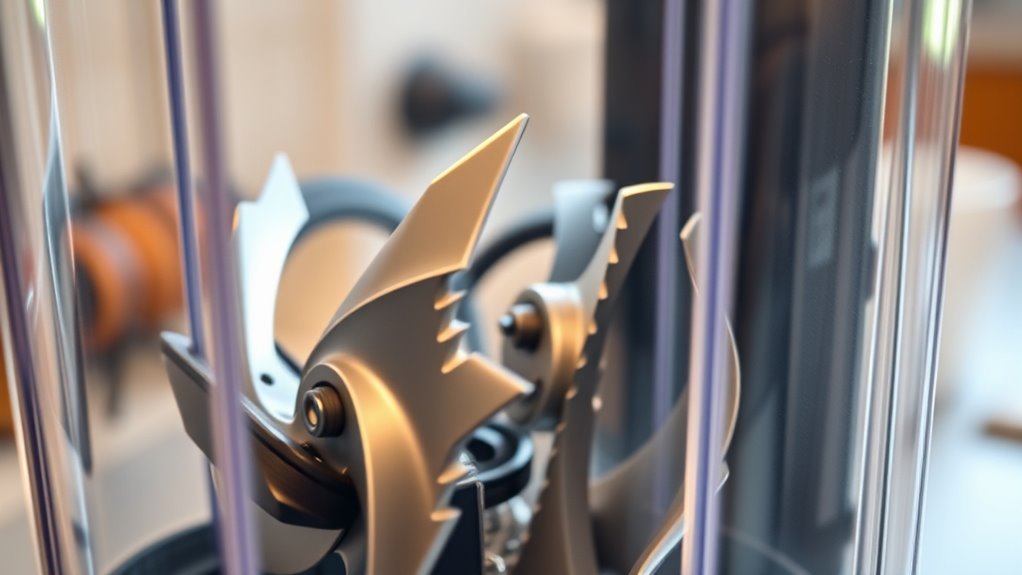
Designing blender blades and motors requires a focus on both durability and safety to prevent failures and protect users. You want blades that withstand constant use without breaking, and motors that don’t overheat or stall. To achieve this, consider:
- Using high-quality, corrosion-resistant materials to guarantee blade safety and longevity.
- Incorporating noise reduction features like sound-dampening covers to minimize loud operation.
- Implementing safety interlocks that stop the motor if the jar isn’t properly assembled.
- Reinforcing blades to prevent bending or shattering during heavy-duty blending.
These measures help assure your blender stays reliable, safe to operate, and user-friendly, giving you peace of mind with every smoothie. Durability combined with safety features keeps both the device and user protected for years to come.
Innovations in Blade Technology and Materials
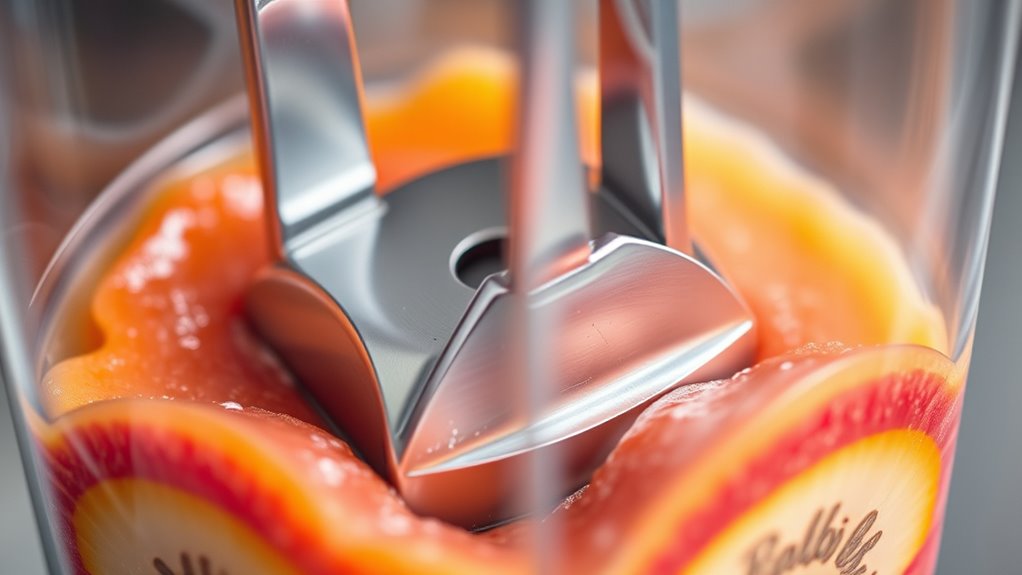
Recent advances in blade technology and materials are transforming how blenders perform and last. Modern blades now feature improved ergonomics, allowing for better control and efficiency during operation, which reduces strain on the motor and user. Manufacturers are also focusing on noise reduction, integrating sound-dampening materials and more aerodynamic designs to create quieter blenders. High-quality, corrosion-resistant materials like hardened stainless steel extend blade longevity while maintaining sharpness. These innovations enable smoother blending, faster results, and less disruption in your environment. Enhanced blade ergonomics ensures easier assembly and cleaning, while noise reduction makes using your blender more comfortable. Overall, these technological improvements make your blender more durable, efficient, and user-friendly, elevating your blending experience to a new level of performance.
The Synergy Between Motor and Blade Design
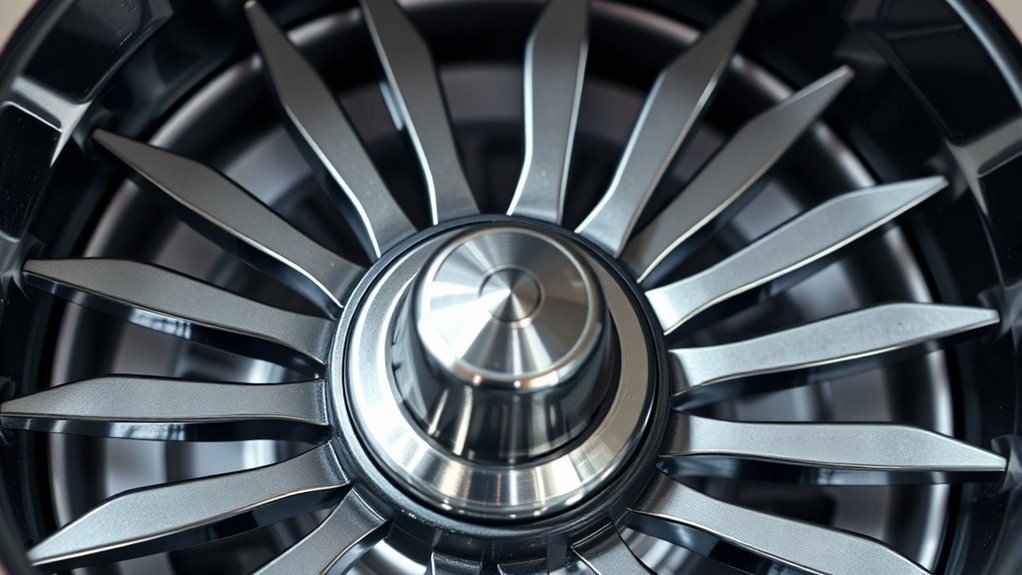
When motor and blade design work in harmony, your blender delivers maximum performance and efficiency. The right balance reduces blade noise, making blending quieter and more pleasant. It also guarantees powerful blades can handle tough ingredients without stalling. To optimize this synergy:
- Choose a motor with adequate torque for your blade design.
- Ensure blades are aligned to minimize wobbling and noise.
- Use blades with smooth edges for quieter operation and easier cleaning.
- Regularly clean blades using proper methods to prevent buildup, which can increase noise and reduce efficiency.
This harmony not only enhances blending results but also makes cleaning easier, keeping your blender in top shape for smooth, consistent smoothies. Proper motor and blade pairing is key to a quieter, more effective blending experience.
Future Trends in Blender Engineering

What innovations will shape the future of blender engineering? You can expect a focus on sustainability, with biodegradable plastics replacing traditional materials to reduce environmental impact. Manufacturers are exploring eco-friendly components that break down safely after use, making blenders more sustainable. Additionally, ergonomic handle design will become more sophisticated, prioritizing comfort and grip stability during operation. Expect handles that adapt to hand contours, improving user experience and reducing fatigue. Advanced materials and thoughtful design will also enhance durability and safety. These trends aim to create blenders that are not only more efficient and user-friendly but also environmentally conscious. As technology evolves, future blenders will seamlessly combine eco-awareness with ergonomic excellence to meet the demands of modern consumers.
Frequently Asked Questions
How Do Different Blade Shapes Influence Blending Efficiency?
Different blade shapes greatly influence blending efficiency by affecting how well ingredients are cut and circulated. You notice that curved blades create better vortexes, pulling ingredients toward the blades, while straight blades offer more direct cutting. Blade material also matters; sharp, durable metals stay effective longer. Proper blade alignment ensures ideal contact with ingredients, maximizing efficiency. Overall, the right combination of blade shape, material, and alignment makes your blending smoother and quicker.
What Role Does Blade Noise Reduction Play in Design?
Think of blade noise reduction as wrapping a whisper in a soft blanket. It plays a vital role in design by incorporating noise dampening materials and sound insulation, which absorb and block sound waves. This not only creates a quieter environment but also enhances user experience. By minimizing noise, manufacturers make blenders more pleasant to use, especially in quiet settings, without sacrificing power or performance.
How Are Eco-Friendly Materials Integrated Into Blade Manufacturing?
You can see eco-friendly materials integrated into blade manufacturing by using biodegradable plastics and recycled composites. Manufacturers often choose biodegradable plastics to reduce environmental impact, ensuring blades break down naturally over time. Recycled composites, made from reclaimed materials, strengthen blades while supporting sustainability. By incorporating these eco-friendly options, you help minimize waste and promote greener production practices without sacrificing performance or durability.
What Safety Features Prevent Blade Accidents During Operation?
You should always check for safety features like a safety lock that prevents the blades from spinning when not in use, reducing accidental injuries. Additionally, blade sharpening is designed to be safe, often requiring you to release or press specific buttons before accessing the blades. These features guarantee you can operate your blender confidently, minimizing risks and keeping safety a top priority during every use.
How Does Blade Design Optimize Energy Consumption?
You might think blade design wastes energy, but it actually maximizes it. By choosing durable blade material and shaping blades for efficient cutting, you reduce unnecessary motor load. Pairing this with appropriate motor power ensures smooth blending without overexertion. This synergy minimizes energy consumption while maximizing performance, so your smoothies come out perfect every time, without wasting electricity or overworking the motor.
Conclusion
You now see how blade brilliance and motor mastery merge to make mighty smoothies. By understanding the intricate interplay of materials, geometry, and engineering, you can choose a blender that delivers durability, dynamism, and design. Remember, the perfect blend begins with precision, power, and passion. So, when you’re ready to revolutionize your routine, trust the tech behind the turbulence and take your blending to the next level.
